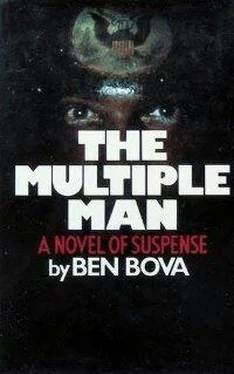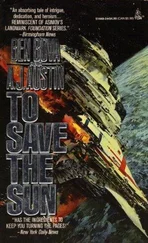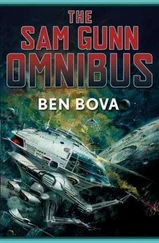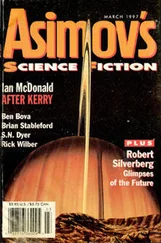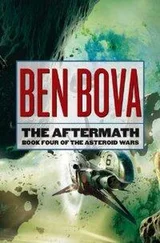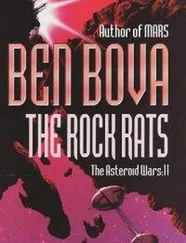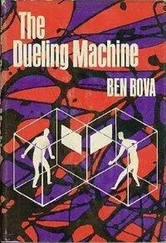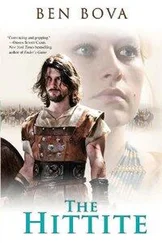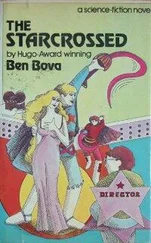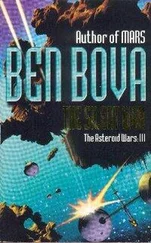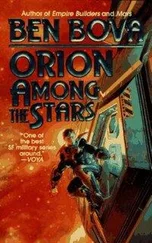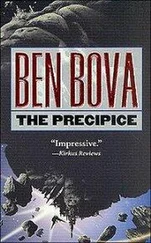“All right,” I said. “Where is he?”
“He’s coming down to meet you. He should have been here by now.” Thornton glanced at his wrist watch.
The cold was seeping into me. “Look, couldn’t we—”
“Dr. Peña is a very frail man,” Thornton told me, and for the first time since I’d met him in the lobby, I got the feeling he was saying something that he really meant. “He’s nearing ninety years of age. He drives himself much too hard. I hope you won’t… say anything that will upset him.”
I stared at Thornton. The life of the President of the United States was being threatened. Hell—one of those bodies could just as easily be James J. Halliday. And he was worried about his boss’s frailties.
There wasn’t time for me to answer him, though. Through a second door, one set farther back in the room than the one we had used, Dr. Peña came riding in on an electrically powered wheelchair.
He looked older than any human being I had ever seen; even Robert Wyatt would have looked coltish beside him. His face was nothing more than a death mask with incredibly lined skin stretched over the fragile bones. His head was hairless, eyes half-closed. He reminded me of the mummified remains of pharaohs; not a drop of juice left in him. He was wrapped in a heavy robe that bulged and bulked oddly. And then I saw all the cardiac and renal equipment loaded on the back rack of the wheelchair, and realized that below the neck he was probably more machine than flesh. His hands were covered with barely discernible thin plastic surgeon’s gloves. It gave his long, bony fingers and the liver-spotted, tendon-ridged backs of his hands a queer filmy sheen.
His voice surprised me. It was strong, confident, alert; not at all the thin, quavering piping I had expected.
“You’re the President’s press secretary, are you?”
“And you’re Dr. Peña,” I said.
He fingered the control buttons set into the wheelchair’s armrest and rolled up to me fast enough to make me involuntarily step back a pace.
“I’m a busy man, Mr. Albano. As you might suspect from looking at me, time is a very precious commodity to me. Why are you taking up my time?”
I almost grinned at him. Frail old man, my ass. “I’m part of the team investigating…” I was momentarily at a loss for how to phrase it. I gestured toward the shrouded bodies.
He glowered at me. “I’ve already told Klienerman and that Secret Service man everything I’ve found out. Ask them about it.”
“I will. But while we’re both here, I’d like to get your opinions firsthand.”
“Waste of time,” he snapped.
“Why?”
“Because I have no opinions!”
“Suppose I asked you if the man sitting in the White House this morning is actually James J. Halliday?”
His breath caught on that one.
I stepped closer to him. “Is one of those… corpses… the President?”
He glanced at Thornton, then back to me. “I can only tell you that each of those corpses looks exactly like the President. Same height, same weight. Same fingerprints, retinal patterns, ear-lobe structure, cephalic index. Every physical determinant I have measured is precisely the same as the records Dr. Klienerman gave me for the President.”
“Fingerprints,” I echoed.
“Everything,” he repeated. “They are physically identical to each other and tothe President. They are not machines, not automata or plastic creations. They are completely human, as human as you or I. More human than I am, considering…”
“Who could produce such exact duplicates?”
Dr. Peña was silent on that one.
“Well… what killed them?” I asked.
His head sank onto his chest. His eyes closed. Thornton stepped between us. “I told you not to tax him too far.”
But Peña waved a feeble hand. “No… it is all right. I’m perfectly capable of… answering him.”
“You should be resting,” Thornton insisted.
“What killed them?” I asked again.
He gave a one-gasp laugh, a nasty accusative little snort. “What killed them? A very good question.An excellent question.”
“Well? What did?”
He looked up at me, his eyes glittering with pain or hate or maybe both. “Nothing killed them. Nothing at all. No marks of violence. No poison. Not even asphyxiation. They simply died. Like marionettes whose strings have been cut. They simply fell down and… died.”
All the way on the flight from Minneapolis to Denver I nibbled on Dr. Peña’s words. Nothing killed them… they just fell down and… died. Cause of death: unknown. They just stopped living. Two adult human males who looked exactly like the President of the United States. Each died within a hundred yards of the real President. Each died of—nothing.
I was out of my league and I knew it. But something stubborn in me (or maybe something scared witless) told me to follow McMurtrie’s trail. McMurtrie knew what he was doing. If he had gone to Aspen to see General Halliday, that’s where I was going, too.
It’s hard to believe that Aspen was once a center of the youth cult. The old city had begun as a silver miners’ boom town, then rusticated for a long while, and then had become a ski resort. Kids from all over the country flocked there a couple of generations ago, to ski and loaf in the winter snows and summer sunshine. Easy living. But all things change. The kids grew up, started businesses, got respectable. Aspen became a very exclusive resort, especially after Colorado followed Nevada’s lead and legalized gambling and prostitution.
Funny. Old Las Vegas had become a ghost town after the Shortage Riots of the nineties. It was really a defenseless city. When Dahlgren led his army of unemployed against the “temples of sin and gold,” as he evangelistically put it, they burned the casinos and hotels to the ground. When they tried the following year to sack Denver, Morton J. Halliday, an obscure colonel in the Colorado National Guard, became a national hero. He saved Denver from the mob. He faced them down with trained, disciplined troops. And then he fed them, put them to work rebuilding the damage they had done in Pueblo and Albuquerque, and became the first honest-to-god hero this nation had seen since Sirica.
So now Aspen was a stronghold of the rich and the elderly, a bastion of wealthy and quiet luxurious living tucked among the mighty guardian peaks of the Rockies. Las Vegas was this generation’s youth center; kids lived out on the desert in communes all around the burned-out Strip, using the still-functioning solar power stations to pump up water from the deep wells.
Flying into Aspen had never improved much from the earliest days. You still had to bounce through the rough mountain air, lurching every which way while the plane’s entertainment tape fed you P.R. garbage about how “the clear air makes the peaks seem much closer than they actually are.”
I had white knuckles and sweaty palms all through the forty-minute flight. By the time we landed, my stomach was in a mess. It calmed down a bit on the taxi ride to the Halliday enclave. You didn’t just drop in on General Halliday. Not even if you worked in the White House. He ruled this area—the whole state of Colorado, in fact—from his mansion on Red Peak—the Western White House, when his son was home. When James J. had first become governor of Colorado, most political pundits had assumed that he was just a front man for his powerful father. They got several stunning surprises when James proved to be his own man. You couldn’t predict the Governor’s behavior by finding out what the General wanted. This caused some towering arguments between them. I’d seen a few that raged from cocktails through dawn.
Читать дальше
